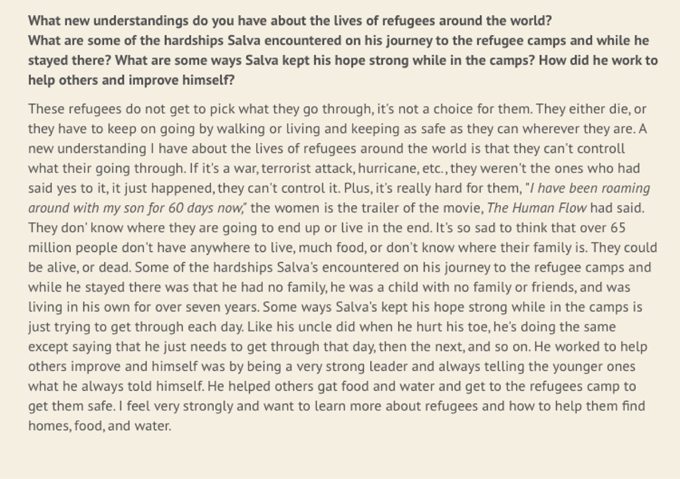The Global Read Aloud (GRA) provides an opportunity for students of all ages to connect with each other to discuss a common text. Using tools such as Edmodo, Kidblog, Padlet, and Twitter, middle grade students participating in the 2017 GRA connected with preservice teachers at Furman University in South Carolina to discuss Linda Sue Park’s A Long Walk to Water. The novel depicts the lives of children in South Sudan through the true story of a Sudanese “lost boy” named Salva Dut who is forced to flee his country due to war and the fictional story of a young Sudanese girl named Nya who spends her days walking to fetch water for her family.
Many students sought to better understand Nya’s daily eight-hour journey to fetch water. One preservice teacher connected with a class in Ontario, Canada, who participated in a “water walk” and shared their experience on Twitter. Using the hashtag #GRAWater, another preservice teacher found a school who planned a similar event and raised money for an international nonprofit.
Below is an Edmodo exchange between a preservice teacher in South Carolina and seventh graders in Indiana discussing the themes of courage and determination in the text.


 Another preservice teacher replied to the Tweet of a cartoon (below) by reflecting on privileges such as access to education that many girls in developing countries, like Nya, do not have. The GRA helped these preservice teachers expand their perspectives on issues depicted in the text and presented them with ways to help students build agency through online discussion.
Another preservice teacher replied to the Tweet of a cartoon (below) by reflecting on privileges such as access to education that many girls in developing countries, like Nya, do not have. The GRA helped these preservice teachers expand their perspectives on issues depicted in the text and presented them with ways to help students build agency through online discussion.

 Using Kidblog, fifth-grade students from Boston, MA, examined how characters in the text demonstrated empathy and considered how they might do the same. They responded to weekly questions about themes from the text and shared their newfound understandings of the hardships children face in South Sudan. Below, one student discussed how the novel helped shape her perception of refugees.
Using Kidblog, fifth-grade students from Boston, MA, examined how characters in the text demonstrated empathy and considered how they might do the same. They responded to weekly questions about themes from the text and shared their newfound understandings of the hardships children face in South Sudan. Below, one student discussed how the novel helped shape her perception of refugees.
 The preservice teachers also connected with a local fifth-grade class who read A Long Walk to Water. These fifth graders extended their reading to include a collection of fiction, poetry, and articles about refugees. The more they learned from their reading and online research about the plight of refugees, the more they became inspired to inform others. They created infographics including facts and figures about countries where large numbers of refugees flee due to persecution.
The preservice teachers also connected with a local fifth-grade class who read A Long Walk to Water. These fifth graders extended their reading to include a collection of fiction, poetry, and articles about refugees. The more they learned from their reading and online research about the plight of refugees, the more they became inspired to inform others. They created infographics including facts and figures about countries where large numbers of refugees flee due to persecution.
The fifth graders then organized a “Walk for Refugees” in their community to raise awareness and collect donations for a nonprofit. They shared about the event at their school and through social media. Because of their efforts, they raised over $3,000 for a nonprofit.
When given meaningful opportunities to use technology to connect readers near and far, students become more engaged with reading, deepen their comprehension, expand their worldviews, and develop a better understanding of themselves and their place in the world. Ultimately, using these tools to connect to a larger audience led students to take action and cultivate change. As Linda Sue Park says, “Can a children’s book save the world? No. But, the young people who read them can.”
The following websites can be used to create infographics:
Katie (Stover) Kelly is an associate professor of education at Furman University in Greenville, SC and coauthor of From Pencils to Podcasts: Digital Tools to Transform K-6 Literacy Practices (Solution Tree) and Smuggling Writing: Strategies That Get Students to Write Every Day, in Every Content Area, Grades 3-12 (Corwin). Find her on Twitter @ktkelly14.
Tatiana Oliveira is an undergraduate preservice teacher at Furman University in Greenville, SC. She is interested in the intersectionality of education and social justice and plans to pursue a master’s degree in literacy. Find her on Twitter @tmoliveira17.
This article is part of a series from the International Literacy Association Technology in Literacy Education Special Interest Group (TILE-SIG).